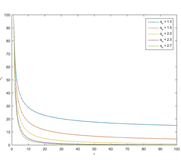Algoritmo de recocido simulado generalizado para Matlab
Main Article Content
Keywords
Recocido simulado, optimización, eficiencia, GSA, Matlab
Resumen
Muchos problemas en física, matemáticas e ingeniería, demandan la determinación del óptimo global de funciones multidimensionales. El recocido simulado es un método metaheurístico que tiene por objeto dar solución a problemas de optimización global. Existen tres tipos de recocido simulado: i) recocido simulado clásico; ii) recocido simulado rápido y iii) recocido simulado generalizado. De entre estos, el recocido simulado generalizado es demostradamente el más eficiente. Matlab, uno de los softwares más ampliamente usados en simulación numérica y programación científica, dispone de una caja de herramientas con funciones basadas tanto en métodos determinísticos como estocásticos capaces de resolver una gran cantidad de problemas de optimización. En este artículo se describió el método de recocido simulado generalizado, se elaboró la función GSA que alberga este método y se aplicó en algunos problemas matemáticos que permitieron evaluar la eficiencia de GSA respecto de algunas funciones de optimización de Matlab. Como resultado, se obtuvo que la función GSA no solo consigue ser efectiva en su convergencia al óptimo global sino que, además, lo hace con rapidez. Así mismo se observó que, en lineas generales, GSA fue más eficiente que las funciones con las que fue comparada. Por tanto, puede concluirse que la función GSA es en una alternativa novedosa y efectiva para el abordaje de problemas de optimización utilizando Matlab.
Descargas
Referencias
[2] C. Carletti, P. Meoli, and W. R. Cravero, “A modified simulated annealing algorithm for parameter determination for a hybrid virtual model,” Physics in Medicine and Biology, vol. 51, no. 16, pp. 3941–3952, jul 2006.
[3] R. V. Vidal, Applied simulated annealing. Springer, 1993, vol. 396.
[4] W. Y. Yang, W. Cao, T.-S. Chung, J. Morris et al., Applied numerical methods using MATLAB. Wiley Online Library, 2005.
[5] A. Barbato and A. Capone, “Optimization models and methods for demandside management of residential users: A survey,” Energies, vol. 7, no. 9, pp. 5787–5824, sep 2014. [Online]. Available: https://doi.org/10.3390/en7095787
[6] O. Erdinc, Optimization in renewable energy systems: recent perspectives. Butterworth-Heinemann, 2017.
[7] C. Tsallis and D. A. Stariolo, “Generalized simulated annealing,” Physica A: Statistical Mechanics and its Applications, vol. 233, no. 1-2, pp. 395–406, nov 1996. [Online]. Available: https://doi.org/10.1016/s0378-4371(96)00271-3
[8] Y. Xiang, S. Gubian, B. Suomela, and J. Hoeng, “Generalized simulated annealing for global optimization: The GenSA package,” The R Journal, vol. 5, no. 1, p. 13, 2013. [Online]. Available: https://doi.org/10.32614/rj-2013-002
[9] G. Giorgi and K. Yamashita, Theoretical Modeling of Organohalide Perovskites for Photovoltaic Applications. CRC Press, 2017.
[10] M. D. de Andrade, K. C. Mundim, and L. A. C. Malbouisson, “Convergence of the generalized simulated annealing method with independent parameters for the acceptance probability, visitation distribution, and temperature functions,” International Journal of Quantum Chemistry, vol. 108, no. 13, pp. 2392–2397, 2008. [Online]. Available: https://doi.org/10.1002/qua.21736
[11] J. E. Dennis, D. M. Gay, and R. E. Welsch, “An adaptive nonlinear least square algorithm,” 1977.
[12] D. E. Golberg, “Genetic algorithms in search optimization & machine learning. 1953.
[13] S. Kirkpatrick, C. D. Gelatt, and M. P. Vecchi, “Optimization by simulated annealing,” in World Scientific Lecture Notes in Physics. WORLD SCIENTIFIC, nov 1986, pp. 339–348. [Online]. Available: https://doi.org/10.1142/9789812799371_0035
[14] F. Glover, M. Laguna, E. Taillard, and D. de Werra, Tabu search. Springer, 1993.
[15] T. Schanze, “An exact d-dimensional tsallis random number generator for generalized simulated annealing,” Computer Physics Communications, vol. 175, no. 11-12, pp. 708–712, dec 2006. [Online]. Available: https://doi.org/10.1016/j.cpc.2006.07.012
[16] J. Deng, C. Chang, and Z. Yang, “An exact random number generator for visiting distribution in gsa,” energy, vol. 2, no. 2, 1987.
[17] M. A. Moret, P. G. Pascutti, P. M. Bisch, and K. C. Mundim, “Stochastic molecular optimization using generalized simulated annealing,” Journal of Computational Chemistry, vol. 19, no. 6, pp. 647–657, apr 1998.
[Online]. Available: https://doi.org/10.1002/(sici)1096-987x(19980430)19:6<647::aid-jcc6>3.0.co;2-r
[18] T. J. P. Penna, “Traveling salesman problem and tsallis statistics,” Physical Review E, vol. 51, no. 1, pp. R1–R3, jan 1995. [Online]. Available: https://doi.org/10.1103/physreve.51.r1
[19] G. Haeser and M. G. Ruggiero, “Aspectos teóricos de simulated annealing e um algoritmo duas fases em otimização global,” Trends in Applied and Computational Mathematics, vol. 9, no. 3, pp. 395–404, 2008.
[20] K.-L. Du and M. Swamy, “Search and optimization by metaheuristics,” Techniques and Algorithms Inspired by Nature; Birkhauser: Basel, Switzerland, 2016.
[21] H. Szu and R. Hartley, “Fast simulated annealing,” Physics Letters A, vol. 122, no. 3-4, pp. 157–162, jun 1987. [Online]. Available: https://doi.org/10.1016/0375-9601(87)90796-1
[22] S. Geman and D. Geman, “Stochastic relaxation, gibbs distributions, and the bayesian restoration of images,” IEEE Transactions on Pattern Analysis and Machine Intelligence, vol. PAMI-6, no. 6, pp. 721–741, nov 1984. [Online]. Available: https://doi.org/10.1109/tpami.1984.4767596
[23] H. Peyvandi, Computational Optimization in Engineering: Paradigms and Applications. BoD–Books on Demand, 2017.
[24] Y. Xiang and X. G. Gong, “Efficiency of generalized simulated annealing,” Physical Review E, vol. 62, no. 3, pp. 4473–4476, sep 2000. [Online]. Available: https://doi.org/10.1103/physreve.62.4473
[25] C. Tsallis, “Possible generalization of boltzmann-gibbs statistics,” Journal of Statistical Physics, vol. 52, no. 1-2, pp. 479–487, jul 1988. [Online]. Available: https://doi.org/10.1007/bf01016429
[26] Y. Xiang, D. Sun, W. Fan, and X. Gong, “Generalized simulated annealing algorithm and its application to the thomson model,” Physics Letters A, vol. 233, no. 3, pp. 216–220, aug 1997. [Online]. Available:
https://doi.org/10.1016/s0375-9601(97)00474-x
[27] Y. Xiang, S. Gubian, and F. Martin, “Generalized simulated annealing,” in Computational Optimization in Engineering-Paradigms and Applications. InTech, 2017.
[28] M. Viswanathan, “Simulation and analysis of white noise in matlab,” Nov. 2019. [Online]. Available: https://www.gaussianwaves.com/2013/11/simulation-and-analysis-of-white-noise-in-matlab/
[29] “Normally distributed random numbers,” 2006. [Online]. Available: https://www.mathworks.com/help/matlab/ref/randn.html
[30] “Gamma random numbers,” 2006. [Online]. Available: https://www.mathworks.com/help/stats/gamrnd.html
[31] “Fmincon function,” 2006. [Online]. Available: https://la.mathworks.com/help/optim/ug/fmincon.html?lang=en
[32] “Lsqnonlin function,” 2006. [Online]. Available: https://la.mathworks.com/help/optim/ug/lsqnonlin.html?lang=en
[33] “Simannelbnd function,” 2007. [Online]. Available: https://la.mathworks.com/help/gads/simulannealbnd.html
[34] “Anonymous functions,” 2006. [Online]. Available: https://la.mathworks.com/help/matlab/matlab_prog/anonymous-functions.html
[35] “Isolated global minimum,” 2006. [Online]. Available: https://www.mathworks.com/help/gads/isolated-global-minimum.html
[36] “Rosenbrock function,” 2006. [Online]. Available: https://la.mathworks.com/help/matlab/ref/fminsearch.html#bvadxhn-6
[37] “Maximing an objective function,” 2006. [Online]. Available: https://www.mathworks.com/help/optim/ug/maximizing-an-objective.html

